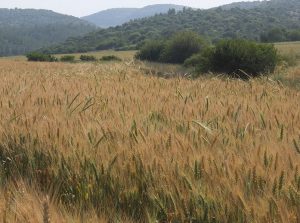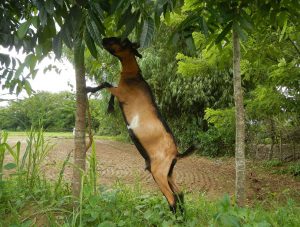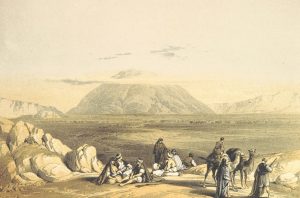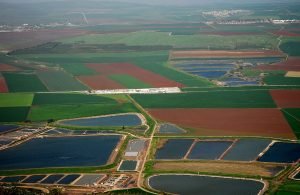After many pages of fascinating conversations about marriage, women and money, Ketubot ends with a love song to the land of Israel. The impetus for these pages of paeans to the land is the final Mishna in the tractate:
“MISHNA: All may force their family to ascend to Eretz Yisrael, but all may not remove others from Eretz Yisrael,” (Ketubot 110b)
After some more halachic discussions, by page 111 the Gemara starts singing the praises of Eretz Yisrael. These words are a beautiful testament to the love that the Sages had for the home of the Jewish people. The land is described as incredibly fertile with produce that seems hard to believe. The fruits mentioned are grapes, i.e. wine; honey and milk as well as wheat, all major staples of the land or part of its description as a land of “milk and honey,” זבת חלב ודבש. The places mentioned as fertile are in the Bet Shean Valley, Zippori and other sites in the Galilee and Golan as well as Hebron and the land of Judah.

Wheat fields in the Elah Valley
Davidbena Wikipedia
One of the strange hyperbolic descriptions on these pages is of a land of milk and honey, but not the honey that we are used to:
“Rami bar Yeḥezkel happened to come to Benei Berak. He saw those goats that were grazing beneath a fig tree, and there was honey oozing from the figs and milk dripping from the goats, and the two liquids were mixing together. He said: This is the meaning of the verse “A land flowing with milk and honey” (Exodus 3:8).” (Ketubot 111b)
The honey described here is not bee honey, or even date honey which the Bible terms honey in the list of the seven species special to the land of Israel. This is fig honey, mixed with goat milk. The Ben Yehoyada (Rabbi Yosef Haim 1835-1909, Baghdad) noticed this aberration and commented on it. He explains that unlike with dates, the fig tree is responsible for both the milk and the honey. Goats cannot graze on date palms, their leaves are hard and prickly and they grow too high up. However, the low growing fig leaves provide the perfect snack for hungry goats. Once they are sated, they can produce lots of milk. Meanwhile, the large and sweet figs produce the “honey.” The Ben Yehoyada supplements this practical explanation with a beautiful spiritual one. One suggested identification for the Tree of Knowledge in the Garden of Eden is a fig tree, since Adam and Eve cover themselves with fig leaves. By producing milk and honey, the fig tree is atoning for that first sin, and the Jewish people understand that it is possible to fix the world and they will do so themselves.

Disclaimer: not a fig tree
Judgefloro, CC BY-SA 4.0 <https://creativecommons.org/licenses/by-sa/4.0>, via Wikimedia Commons
While the descriptions here are clearly exaggerations (grape clusters as big as goats), there is a sense that the rabbis are describing a reality of thriving agriculture and a strong economy. In fact, some rabbis found it hard to live with the duality of a fertile and blessed land and an evil occupying power. Here is what Rabbi Yehoshua ben Levi had to say about how the land looked under the control of Rome:
“Rabbi Yehoshua ben Levi said: O earth, O earth! Gather in your fruit. For whom do you produce your fruit? For these gentiles who stand over us in our sins?” (Ketubot 112a)
Whether the occupiers were worthy of it or not, the land continued to produce fruit during the Roman and Byzantine periods. However, it eventually suffered a long decline. Descriptions of the Jezreel Valley, one of the most fertile places in Israel, in the mid-19th century tell of a region hit with the plagues of swamps and barrenness. Visitors and pilgrims exclaimed over the sad state of the land. Here is Mark Twain’s description:
“Palestine stands in sackcloth and ashes. Over it broods the spell of a curse that has withered its fields and fettered its energies. . . Palestine is desolate and unlovely. And why should it be otherwise? Can the curse of the Deity beautify a land?” (Mark Twain, The Innocents Abroad)

Illustration of Mount Tabor in The Innocents Abroad
Catherine Tobin (–1903), Public domain, via Wikimedia Commons
Centuries earlier, Nachmanides (1194-1270, Spain and Israel) in his travel to the land, also was struck by how it had ceased to thrive. He attributed this to the fact that Gentiles ruled in the land, and he understood that with the return of the Jews the land would produce again, In his commentary to VaYikra 26: 32 “And I will bring the land into desolation; and your enemies that dwell therein shall be astonished at it,” he says:
“And these words promise redemption more than any of the visions of Daniel. And when it says “and your enemies will be astonished by it,” this is good news, informing us that our land cannot accept our enemies, and this is a great proof and promise, because you cannot find another land as fertile and as prosperous that is now so destroyed, because since we have left it is has not accepted any nation or language and all try to settle it and cannot succeed. “
The Zionist miracle of making a barren land flower again is evident to anyone who stands and looks down at the Jezreel Valley, today the breadbasket of Israel, and not far from the rabbis’ enthusiastic picture of a flourishing land:

Jezreel Valley
התמונה צולמה ע”י טל עוז, CC BY 2.5 <https://creativecommons.org/licenses/by/2.5>, via Wikimedia Commons
The final phrase of the tractate states that in the future even the barren trees will bear fruit. The Ben Yehoyada adds a metaphorical meaning. He explains that people are compared to trees in the Torah, כי האדם עץ השדה. Torah scholars are fruit-bearing trees but ignorant people are like the barren trees that bear no fruit. But in the future, when mankind has repented of its sins, even the Amei Haaretz, the ignorant people, will have Torah knowledge.
May we return to you Masechet Ketubot, with renewed energies and more Torah knowledge!










